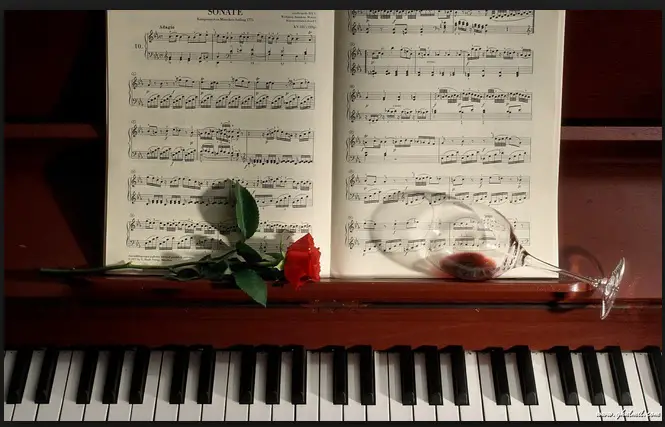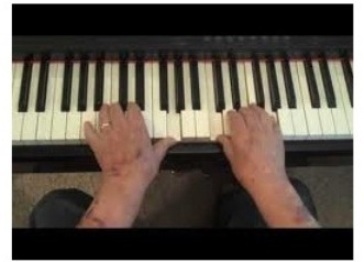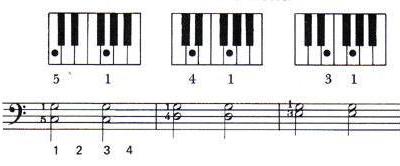
Here are tips and techniques on how to harmonize melodies on the piano, in this free online piano lesson. This free online piano lesson will help you sound like a pro with your piano playing.
 Harmonization means taking the harmony which is already provided and altering it so that it still sounds good, and the monotony is broken. Jazz players do this all the time, as jazz is all about re-harmonization.
Harmonization means taking the harmony which is already provided and altering it so that it still sounds good, and the monotony is broken. Jazz players do this all the time, as jazz is all about re-harmonization.
Here are tips and techniques on how to harmonize on the piano, in this free online piano lesson. Don’t worry if it sounds a bit challenging initially. Most piano players who are able to do this take several years to reach this stage where they are able to play these chords effortlessly.
Playing the same chords after some time can be boring, and it can also sound dull repetitive after some time. That is why most pianists try to improvise; though it is another thing that most also try to show-off, but the fact is that you can make your playing sound fresh by using proper chord substitutions.
If you have spent some time learning to play the piano, I’m sure you would have at least heard how important harmony is. After all, you don’t play the piano with just one hand. You use both your hands so that you can harmonize the melody that you play.
Basically, what it means is that you play additional notes and chords that go well with the notes of the melody that you play so that the overall hearing experience is good.
You can try this out for yourself.
Just play any song that you know, only with the melody part, and once you are done try repeating the same thing with both your hands, and now you hear the difference.
I’m sure you’ll agree now why harmonizing is important, and why so much importance is given to learning it.
How to Harmonize on the Piano
To begin with you can use just the primary chords.
For example, if you’re playing the song on the C scale then you can use the C, F and the G major chords to harmonize.
Why only these three chords?
That is because among these three chords, it covers all the notes of the C major scale.
So to begin with, you should be able to harmonize many songs using these chords, so go ahead and start using these chords.
Okay, so now you’ve already learnt about the importance of chords, and how important harmonizing is, if you want your piano playing to sound good. You’ve also read about the primary chords in any scale, and how they can be used to harmonize most sounds.
But are you still confused or looking for more examples on how to play the chords on top of the melody?
As I said, there are times when you let your ears be the judge and not follow any rules rigidly.
For example, if the melody line contains G E G A C, then the C major chord on its own should be sufficient to go along with the melody notes.
But then piano players always try to improvise to prevent it from sounding monotonous.
So here are a couple of things you can do to make it more interesting. You will need to know the F chord (and the A minor in case you know how to play it).
So these are some of the ways in which you can harmonize melodies on the Piano.
More Substitution Techniques: How to Re-harmonize on a Piano
The simplest of them all is to use the relative minors of the major chords.

So, for example, instead of the chord C you can choose to play the relative minor of chord C, which is “A minor”. So you can use “A minor”, as long as the melody tolerates it and doesn’t seem to be really out of place.
Another example, albeit a bit difficult to play, involves using four notes chords. Here you can replace a “seventh chord” with a “minor seventh” that is a “fourth” below it.
So for example, you can substitute C7 (dominant seventh cord) with Gm7 (minor seventh) that is a fourth below.
There you go. A couple of simple but effective techniques that you can use right away! This is how to re-harmonize on a Piano.
More Techniques for Harmonizing on the Piano
Here are more tips and techniques for harmonizing on the piano. This free online piano lesson will help you to effectively accompany any song.

We have already seen a few techniques on how to harmonize on the piano, but here are more techniques for harmonizing on the Piano.
- Use the relative minor chord of the major chord mentioned. So A minor instead of C major
- Use a minor seventh that is fourth below the dominant seventh mentioned. So Gm7 instead of C7Use the sixth chord instead of playing just the major chord. So C6 instead of just the C chord
- In general, you can explore all the chords that contain the note, and see what would be a best fit. As long as things sound okay you could use any of those matching chords.
As you can see some of these are quite easy and can be implemented right away, but for others you need to practice and give yourself time. You can still harmonize a lot of songs using the methods outlined above.
So use these techniques to harmonize on the piano.
KeytarHQ editorial team includes musicians who write and review products for pianists, keyboardists, guitarists & other musicians. KeytarHQ is the best online resource for information on keyboards, pianos, synths, keytars, guitars and music gear for musicians of all abilities, ages and interests.



Leave a Reply